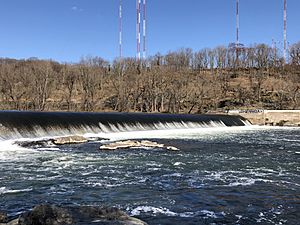Flat Rock Dam (Pennsylvania) facts for kids
Quick facts for kids Flat Rock Dam |
|
|---|---|
 |
|
| Official name | Flat Rock Dam |
| Location | Philadelphia-Montgomery counties, Pennsylvania, USA 40°02′23″N 75°14′49″W / 40.03972°N 75.24694°W |
| Opening date | 1970s |
| Dam and spillways | |
| Impounds | Schuylkill River |
The Flat Rock Dam is a special kind of wall built across the Schuylkill River in Pennsylvania. It's called an "earthen dam" because it's made mostly of earth and rock. A lot of water flows through this dam every second!
This dam is part of Flat Rock Park. Lower Merion Township in Montgomery County, Pennsylvania, takes care of the park. You can find the dam near the Schuylkill Expressway in Gladwyne.
What is the Flat Rock Dam?
The Flat Rock Dam is more than just a wall in the river. It's part of a much older system. This system includes locks and waterways. These were built a long time ago by the Schuylkill Navigation Company.
The main job of this system was to help move coal. Coal from places like Port Carbon could travel by boat all the way to Philadelphia. The dam helped by creating a calm pool of water. This pool made it easier for canal boats to travel. It also directed water to the Manayunk Reach, another part of the waterway.
A Bit of History
Building the Flat Rock Dam was a big project. Construction started in 1815. An engineer named Ariel Cooley from Massachusetts helped design it. He also worked on the Fairmount Dam.
The dam and its locks were finished in 1818. This was a very important time for moving goods. The waterways helped cities grow by bringing in needed supplies. The dam has been updated over the years, with its most recent opening in the 1970s.
Future Plans
There are plans to make the Flat Rock Dam even more useful. Engineers want to add special machines called turbines. These turbines will use the flowing river water to create electricity. This is called hydroelectric power.
The project aims to generate about 1.5 megawatts of electricity. That's enough power for many homes! This shows how old structures can be updated for new, clean energy uses.

